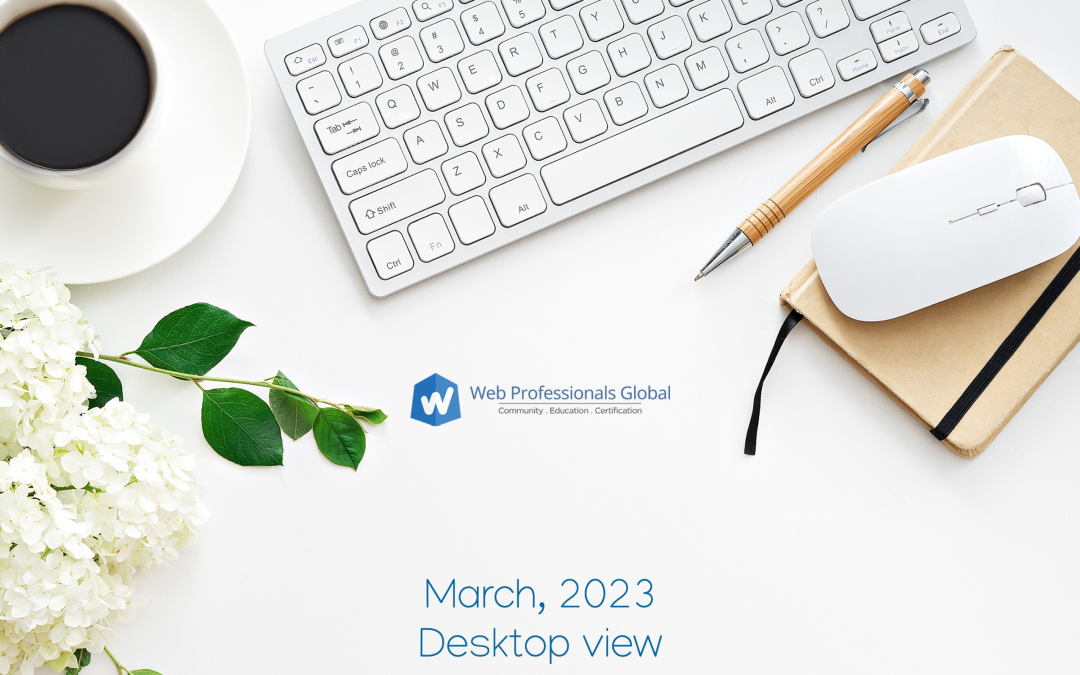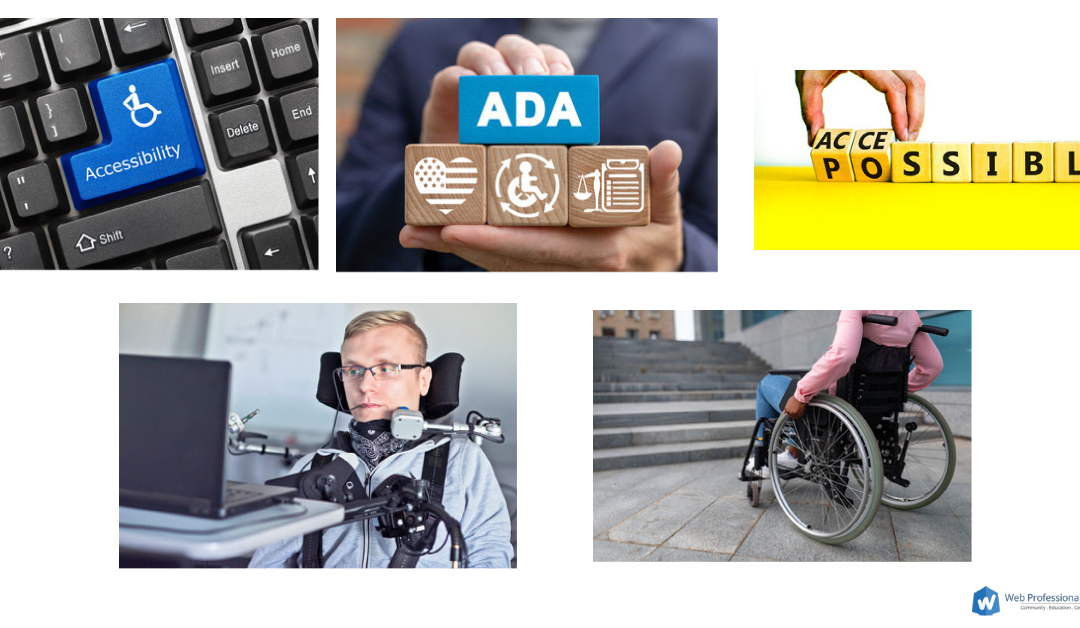
by Mark | Mar 27, 2023 | AI and Machine Learning, CSS3, Web Accessibility, Web Professional Trends
March has been a most interesting month in terms of new advancements in web design and development. Here are just a few articles we found interesting this month. Perhaps a bit of a directed stream of our thoughts supported by articles. Admittedly, some were published prior to March and we just encountered them. We encourage you to review these articles and follow along with the stream as we focus on:
- AI (and accessibility) – yes, they go together in many ways,
- CSS,
- JavaScript, and
- Website sustainability.
AI (and accessibility)
First, let’s examine a recent post by Brad Frost concerning “design systems in the time of ai.” As mentioned at the end of the article “…AI makes it crystal-clear we need to be focusing on why we create things vs what/how we create.” In a nutshell, AI can be used to improve efficiency in what is created. We can be leveraging the power of AI to reduce the mundane tasks and focus on what is important.
So, what does AI have to do with accessibility? It can help tremendously. Last year, Accessibility.com published a great overview of “How Artificial Intelligence is Improving Accessibility.” This is a rapidly evolving landscape, and we can think in terms of AI-supported voice assistants helping those with visual impairments, AI driven transcribing can help with those experiencing hearing impairment. Likewise AI tools can help with speech impairments (think in terms of Parkinson’s or brain injuries)as well as mobility impairments. We encourage you to read the linked article to learn more.
Accessibility
Focusing solely on accessibility, we found the Guide to Accessible Form Validation by Sandrina Pereira to be most informative. She correctly asserts that when we build form validations from scratch we often overlook accessibility. Sandrina focuses on both usability and accessibility. We found this article to be a solid introduction and encourage aspiring web professionals to develop such an approach in all their work.
We also encountered this solid article dealing with color contrast. Yes, this is something everyone finds very annoying. We liked the subtitle – “Web Accessibility for Text & UI Design.” Good thesis – always make your UI components easy to identify.
CSS
Getting started with style queries by Una Kravets is a solid read also. The ability to query a parent object’s inline size along with container query unit values has achieved stable support in modern browser engines. Una covers the fundamentals of working with these and provides useful examples (including code snippets). Of course, this technology continues to expand and you should be come familiar with these approaches whether you are a practicing web professional or an aspiring one.
JavaScript
Sandworm audit is a command line tool to identify vulnerabilities, malicious scripts, license, and metadata issues. It is free and open source and works with any JavaScript package manager. Have you tried it out? What are your thoughts?
For those who like a bit of spice with their JavaScript, we encountered Jared White’s “Great gaslighting of the JavaScript Era” article. This article represents a cogent view of many of the internal discussions we have been holding for several years. The web is built on standards and protocols. Your site is based on HTML, but can be served from any operating system on any hardware any place on our planet. You do not need a JavaScript framework to build a simple website. We seem to have forgotten that. Yes, I have personally seen sites relying on large JS libraries to display what could be done in a few lines of HTML (and stuled with a bit of CSS). Good article (and we agree with you Jared). This article is also a great segue to the issue of website sustainability (see below).
Website Sustainability
Alexander Dawson published an interesting article on the carbon impact of web standards in January, 2023 (yes, we just encountered this one and it is worth reading). Given that the Internet is a major source of carbon pollution, it is important to think in terms of sustainable web design. Yes, Greenpeace recently reported that if the Internet were a country, it would be in the top 10 carbon emitters. The BBC published an overview of the extent of the problem a few years ago. Yes, the WWW is highly dependent on electricity (and the source of much of that electricity is not carbon neutral). Alexander focused on HTML and CSS and how much energy was required to render a basic boilerplate. He relied on different browsers, different hosting providers, different equipment and different locations (among other variables).
His test suite consisted of nearly 300 HTML elements and attributes, over 500 CSS rule, selector, and property tests, and over 50 media and other specification tests. He noted that embedding interactive content caused the use of a significant amount of CPU, GPU, RAM, and data usage. Non-standard code triggered rendering issues as well. with respect to CSS, animation (specifically keyframe animation) and the use of custom fonts caused a dramatic impact. For media formats, SVG is the best. We thought his conclusion (below) summarized that major changes are needed.
Existing evidence shows that websites are getting more bloated [54], sites remain largely inaccessible [55], and with JavaScript taking higher importance than basic semantics in tooling practices, the backbone of the web (HTML & CSS) have become clogged with un-performant code. The existing web needs a firm shake-up if it is to meet it’s commitments to become sustainable (and user-friendly).
Your thoughts?
Yes, that was a lot to examine this month. We are keen to learn what you liked and what areas you would like us to examine in greater detail. We look forward to your comments.

by Mark | Dec 15, 2022 | Web Accessibility
Illinois senator Tammy Duckworth sponsored the “Websites and Software Applications Accessibility Act‘ in September. This link will open in a new browser tab and is a synopsis. Although this is proposed legislation and we do not know if it will eventually become law, we (at Web Professionals Global) thought it important to mention this as we near the end of the year.
If enacted
Although the future of this law is presently not known, it is important to note some of the key aspects of this proposed legislation. This would make it unlawful for entities covered by the ADA (Americans with Disabilities Act) “to maintain inaccessible websites and applications that exclude or otherwise discriminate against people with disabilities.” There would be a clear and enforceable accessibility standard with a technical assistance center and an advisory committee. The latter would provide advice on making websites and applications accessible. A study addressing emerging technologies would also be authorized. Quotes are from the above link.
Note the mention of clear and enforceable standards. In many cases, current laws seem vague and significantly lagging behind technology. Clarity will certainly help. Note also the proposed technical assistance center and advisory committee. In our opinion, these two items have been sorely lacking from most legislation. Most businesses simply lack the resources to “figure it out” on their own.
Why now?
Given what we have experienced with the pandemic, we all should understand better what it is to be excluded from a digital environment. Accessibility is experiencing significantly increased interest and awareness these days. We suspect accessibility laws are only going to be strengthened in the near future. As practicing web professionals, we should be helping our clients understand the importance of making websites, apps, and emerging technologies accessible (augmented reality, virtual reality, NFTs and more).
Want to know more?
We recommend this great article by Lainey Feingold which discusses this legislation in much greater depth.
What are your thoughts on accessibility as it relates to emerging technologies? We look forward to reading your comments.
by Mark | Nov 30, 2022 | CSS3, ECommerce, HTML5, Web Accessibility, Web Security
Here at Web Professionals Global, we hope everyone has been experiencing a successful November. It is time again to focus on a few items which caught our attention during the month. We never cease to be impressed at how quickly web technologies change. Let’s briefly focus on these areas for now:
- CSS,
- Accessibility, and
- Security
CSS
Browsers are beginning to support media query range syntax. Sure, it is not supported in all browsers on all devices yet, but knowing this is coming is huge. It should save significant time coding CSS. Instead of having to specify specific media sizes, we may soon be able to employ mathematical symbols such as >, <, <=, and so forth. Perhaps we can avoid min-width and similar bits as this is supported more and more. Readers are encouraged to follow the above link (it will open in a new tab) to learn more. Please let us know what you think about the possibilities of this via comments.
Accessibility
Adrian Roselli posted an article earlier this year on buttons, enter and space. From a user experience perspective, this is a great refresher on what happens when you use native keyboard interactions. Adrian even provides a working example (with counters). His last word in the article is something we advocate all the time – test. What are your thoughts about keyboard interactions?
Let’s not overlook e-commerce accessibility either. We came across this article specifying UI elements using roles. As many of our readers know, specifying the purpose of UI elements is critical when visitors to a site rely on assistive technologies. We thought this article provided a great number of insights and examples. We look forward to your thoughts on this topic as well.
Security
As we approach the end of the year (and many of us have to provide tech support to family and friends as they receive new devices), it might be wise to bookmark the OUCH newsletter site. Disclosure, Mark (your executive director) is one of the monthly reviewers of these articles before they go live. Each month, a security professional provides a timely overview of one aspect on security. Articles are kept short and are suitable for sharing with those not as savvy in various aspects of technology.
That is all for our November desktop view. We know your time is valuable and appreciate you reading this post. If you would like us to include additional articles or focus on additional aspects, please let us know via your comments below. Until next time…
Best always,
Mark DuBois, Executive Director
Web Professionals Global (aka World Organization of Webmasters)
by Mark | Oct 30, 2022 | CSS3, Industry News, JavaScript, Web Accessibility, Web Security
It has been some time since I posted some thoughts on the current state of web technologies. A lot has happened during recent months. Let’s focus on several key areas:
- web accessibility,
- security,
- JavaScript,
- and CSS.
More areas may be the focus of subsequent articles. Stay tuned. As always, we at Web Professionals Global are interested in what you think. Let us know in the comments or contact us directly.
Web Accessibility
WCAG 3 has been released as a draft (published in December, 2021). Latest editors draft updated as of July, 2022. The approach is iterative with content ranging from temporary (just a placeholder for future content) to mature (ready for publication). This version is somewhat evolutionary in that it will be easy to understand and provide guidance. A key differentiator is that this version has a broader scope (beyond web content). I encourage you to view the above links and consider helping develop the next version of Web Content Accessibility Guidelines.
Of course, there is also a new ARIA authoring practices guide website. Lots of patterns and resources. Check it out.
Security
This is a bit beyond web security, but definitely something readers should be aware of – ransomware attacks which target home PCs (delivered by fake Windows 10 or anti-virus updates). This is called Magniber (details can also be found at this ZDNet article). Essentially, a visitor is directed to a website (although it looks legitimate, it is controlled by malicious individuals). That site informs the visitor their computer operating system or software is out of date and they need to update it as soon as possible. The visitor is tricked into downloading a malicious JavaScript file which contains the malware payload. Once installed (via as technique called DotNetToJscript) the individual’s hard drive is encrypted. They are directed to a link to negotiate payment to recover their contents. More details can be found in the above article.
As web professionals, we should remind ourselves (and our clients of some fundamental tactics which help mitigate these sorts of attacks.
At a minimum, never act on anything that purports to have an extreme sense of urgency. That is what malicious individuals want. Act before you have a chance to think about the implications. It is also good practice to never click on links in emails or text messages. Instead, open a browser and type the site directly (or use a reliable search engine). Lastly, only install updates from trusted sources (and use the traditional channels where those updates are distributed).
JavaScript
The creator of JSON made an interesting comment about JavaScript a couple months ago. Douglas Crockford stated that “The best thing we can do today to JavaScript is to retire it.” Yes, JavaScript is the world’s most popular programming language (used by over 65% of developers according to a StackOverflow survey). Yes, it is bloated (and is becoming more so over time. However, it powers the majority of web sites. Of course, JavaScript is supported in every browser so making a change to something else would be a monumental undertaking. We are curious what your thoughts are about JavaScript. Is Douglas Crockford correct? Please discuss in the comments below.
CSS
Remember the days of aural style sheets (yes, they were a thing). Of course, no browsers supported them. However, a recent article (October, 2022) has raised some hope for me again. Why we need CSS speech is the article. What are your thoughts about CSS speech? Again, reach out to us in the comments.
Of course, there are many enhancements in the works for CSS. These include items such as:
- The ability to nest selectors is presently in the works. This is possible a good way to organize your CSS code. Of course, no browsers yet support this.
- Cascade layers (which give authors the ability to group their CSS and affect how the cascade applies). The linked article should give you a much better understanding. This is like nesting selectors, but much more. Is this feature ready for prime time? No, but you might want to start learning about them.
- CSS subgrid allows for styling on a page to inherit the parent’s grid styling. MDN has a nice overview with examples. That is the reference linked at the start of this bullet.
Now you know a little more about what is happening with respect to web accessibility, security, JavaScript, and CSS. Please let us know if you find this information helpful and provide more thoughts in the comments below.
Best always,
Mark DuBois, Executive Director
Web Professionals Global (a.k.a. World Organization of Webmasters)

by Steve Waddell | Jul 11, 2022 | Web Accessibility, Web Conference, Web Design, Web Development, web standards, WOW News
Our organization was proud to help facilitate the web design contest at the national SkillsUSA competition in Atlanta, GA from June 19-24, 2022. Our team arrived on Sunday, set up Monday and Tuesday, and ran the high school competition on Wednesday and post-secondary competition on Thursday. We also organized a Thursday evening debrief and meet and greet with industry professionals and participated in the overall awards ceremony on Friday evening. We would like to thank all our team members for using their vacation time to support SkillsUSA and the web design contest.
This year, the web design contest teams were greeted with messages in Spanish, German, Chinese, French and Arabic from our international members. One of the benefits of our organization is that our community is made up of members from all over the world, and our international experience and membership helps to craft the real-world challenges that our competition delivers. We are about helping to create and support whole professionals ready to work both domestically and internationally—especially in this age of remote work.
The Contest
The competition was held at the Georgia World Congress Center, and the competitors were teams of two from different states in the country. The teams were tasked with creating websites for clients, all while completing specific tasks in the process to demonstrate web design proficiency.
We were able to utilize the online technologies we developed in 2020 and 2021 when we ran the contest fully online due to COVID-19. This design allowed all competitors on-site to participate—whether they had a laptop, PC, Mac, or Chromebook. All tools were available online and were the same for each of the teams. This meant the teams could focus on listening to and meeting the client’s needs, fundamentals and creativity to win the day. Our new system allowed us to judge all the competitors’ work online, which improved the efficiency of judging the final products that the teams designed.
It should be pointed out that this competition is far more than just a competitive challenge. We at Web Professionals Global, which started the competition in 2004, brought our mission of “Community, Education and Certification” to the competition. Our community of professionals developed the competition challenges and judged the work of each team. We also provided training before the event to help give the competitors the chance to learn about trends in the industry and more about what it takes to be competitive in this in-demand and high-paying career pathway.
Just like in the real-world, each team met with the client whom they were building the website for. This provided the competitors with a real-world environment to get a taste of what it is like to work as a web design professional. After the event, we held a Q&A event with the web design professionals who had been part of the judging team. This was an opportunity for the teams to hear from professional web designers about personal experiences, how to get started, the ups and downs of the career pathway, day-to-day experiences on the job, and how to set themselves apart and on the path of success.
To learn more about Web Professionals Global or the SkillsUSA competition, contact us today. We would love to chat with you.

Jonathan, the client, holding a meeting with all of the competitors Wednesday morning at the beginning of the event.

David Jackson and Bryce Hickson, web designers and lead judges, speaking to the high school and post-secondary competitors in the competition debrief on Thursday.

The competitors chatting with David and Bryce after the debrief.

Mark DuBois, Executive Director, Web Professionals Global, handing out awards at the ceremony on Friday night.

by Steve Waddell | Feb 11, 2022 | User Experience, Web Accessibility
Web accessibility is the practice of making websites and web tools accessible to as many people as possible, and it is rapidly growing in importance in the world of web design and development. The web levels the playing field for people from all different walks of life and removes barriers for people who may have disabilities and struggle in one way or another in the physical world.
With more people than ever working and learning from home, it is important to make sure websites and web tools are properly designed so that no user is left out. Poor website and web tool design can limit accessibility, often unintentionally. It is up to web designers and developers to ensure the products and services they offer can be easily utilized by everyone.
In addition to supporting people with disabilities, accessibility can include other groups that are often marginalized such as populations in rural areas, populations in developing countries, and older populations. Additionally, improving accessibility is a good business decision as it improves the overall user experience for all users. An increased focus on accessibility can spearhead new product and service offerings as well as expand market share. Once accessibility becomes a priority for you and your organization, it will become an integral part of the design process.

Let’s take a look at some of the most common disabilities, and how smart design can make the web accessible for all.
Cognitive impairments
This group includes people with a wide range of disabilities including learning disabilities and mental illness. The most common issues this group has when using the web are difficulties understanding content on websites and how to navigate complex web page layouts. To help this group, designers can focus on making easily understood content by delivering the content in more than one way, such as text, video, and text-to-speech. Maintaining a consistent web page layout and making forms easy to understand and submit are other ways to ensure accessibility for this group.
Mobility impairments
This group includes people with different disabilities ranging from physical impairments to neurological conditions. Disabilities include difficulties moving a mouse around on the computer screen and conditions that require assistive technologies such as speech recognition. Designing a website that can be fully navigated with just a keyboard can go a long way toward meeting the needs of this group.
Visual impairments
This group includes people with blindness, limited vision and color blindness. To help this group, it is important to include tools with zoom capabilities for websites and web tools. It is also helpful to include screen readers so that users can opt to have the text on the site read aloud to them.
Hearing impairments
This group includes people who are completely deaf or partially hard of hearing. To keep websites accessible for people in this group, make sure all audio content is transcribed and all video content has closed captioning easily available.
Designers and organizations often publish accessibility statements on their websites to provide an overview of accessibility policies and what steps have been taken to improve in this area. This can be a good way to be transparent, and it is also an opportunity to solicit feedback from users about areas for improvement.
The World Health Organization states that over 1 billion people—15% of the global population—have a disability. By not incorporating accessibility into websites and web tools, designers and organizations miss out on a massive number of people who might otherwise be potential users. Accessibility in web design is the right thing to do, makes the experience better for all users, and can help businesses grow worldwide. For more information on web accessibility, contact us today.
Read More: Taking a Look at Cybersecurity









